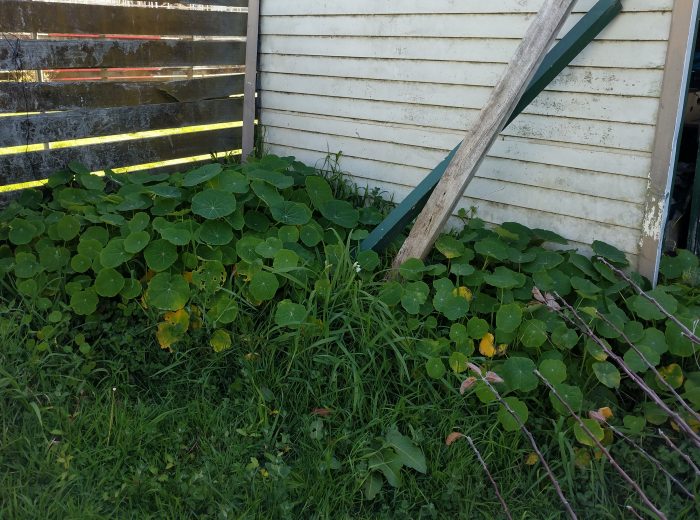I have of late been making the closer acquaintance of my garden fork, also known as a digging fork, which is most certainly the use I have been making of it. I hatched a plot over winter to turn an overgrown section of lawnish area (presently hidden from the house by a derelict shed) into a vegetable garden.
The patch started out looking like this:
Observant gardeners among you will have noted that the section or plot in question appears to be mainly growing nasturtium. Appearances can be deceptive. Under what one might call the canopy of nasturtium lurks all manner of things, most notably mint.
What previous occupant of this dwelling was daft enough to plant a hairy and blah-tasting form of mint, I do not know. In my experience, the only way to prevent a mint plant getting out of hand is to keep eating it, and for this to work it is essential that the mint be palatable. Even the nocturnal nommers didn’t want this stuff – they were busy eating the good mint which I actually wanted, in the front garden.
Once the mint has got out of hand, mind you, there is nothing for it but the Digging Fork. Locusts will not do – they only eat the green bits. Vitriol will not do – it might dissolve everything above ground, but what of the roots? Bombs will not do – a mint-free crater will result, perhaps, but also widespread mint shrapnel which will inevitably take root. Forward the Fork.
This inherited mint is well and truly out of hand, rampaging all across the back garden and, for all I know, busily tunnelling under the house. So I got to work with the fork (which will be earning a name of its own at this rate of trusty service). Approximately one month of fork-related efforts later, the garden now looks like this:
Decidedly, we progress. Still some way to go, of course, but I have every expectation of beginning to plant in the actual ground over the course of the next week, albeit only at one end to begin with. (This was always the plan. I do not need five broccolis, sixteen spinaches, and untold peas etc etc etc all coming ripe at once.)
But more has been removed from the ground than may at first appear. As well as the enormous black bag of weed roots – now too heavy to lift, but hopefully prepared to do its duty and compost its contents in due course – there were also four modestly sized potatoes, a horde of tiny ones (all reinterred in the corner), one massive one (awaiting culinary disposal), a quantity of assorted rubbish, and, er, this.
Whatever this is.
I thought at first it was a tragically foreshortened crochet hook, but the narrow end is smooth, not snapped off. The wider end has a series of serrations in rings as it approaches a sort of rusted metal implant in the very end. So far so mysterious. The best clue I had came from discovering that it was engraved with the cryptic message Gestetner RP5.
Are there any Gestetner-using readers out there who can tell me what this is and what it was for? What it was doing in my veggie patch is, I fear, a mystery too great for human fathoming. But perhaps it will be able to start a new life as a dibber once its immigration status has been cleared up.




In my far-distant high school days, when Xerox photocopiers were high-tech and high-priced, teachers had to use much simpler methods of producing a class set of worksheets, exam papers, or printed material not found in textbooks.
A Latin teacher told us that in the weeks before school exams, there was a great use of the Gestetner equipment for these, including a shared ‘stylus’ [Latin for “sharp pen used for writing on clay tablets or wax tablets”].
I think it’s a stylus, possibly with the sharpest part removed.
Aha! Would the sharp bit be the metal (formerly) coming out of the widest end? The wide end does have the ridges, so that does make sense.
A quick image search reveals something looking very similar, only with the metal point still in place – mystery solved!